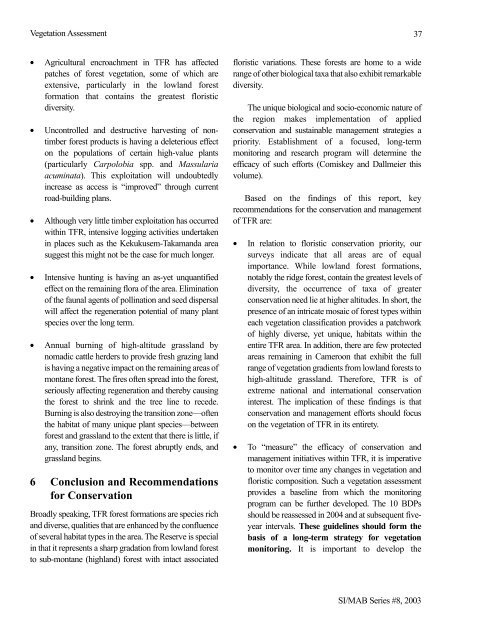Fisheries in the Southern Border Zone of Takamanda - Impact ...
Fisheries in the Southern Border Zone of Takamanda - Impact ...
Fisheries in the Southern Border Zone of Takamanda - Impact ...
Create successful ePaper yourself
Turn your PDF publications into a flip-book with our unique Google optimized e-Paper software.
Vegetation Assessment<br />
• Agricultural encroachment <strong>in</strong> TFR has affected<br />
patches <strong>of</strong> forest vegetation, some <strong>of</strong> which are<br />
extensive, particularly <strong>in</strong> <strong>the</strong> lowland forest<br />
formation that conta<strong>in</strong>s <strong>the</strong> greatest floristic<br />
diversity.<br />
• Uncontrolled and destructive harvest<strong>in</strong>g <strong>of</strong> nontimber<br />
forest products is hav<strong>in</strong>g a deleterious effect<br />
on <strong>the</strong> populations <strong>of</strong> certa<strong>in</strong> high-value plants<br />
(particularly Carpolobia spp. and Massularia<br />
acum<strong>in</strong>ata). This exploitation will undoubtedly<br />
<strong>in</strong>crease as access is “improved” through current<br />
road-build<strong>in</strong>g plans.<br />
• Although very little timber exploitation has occurred<br />
with<strong>in</strong> TFR, <strong>in</strong>tensive logg<strong>in</strong>g activities undertaken<br />
<strong>in</strong> places such as <strong>the</strong> Kekukusem-<strong>Takamanda</strong> area<br />
suggest this might not be <strong>the</strong> case for much longer.<br />
• Intensive hunt<strong>in</strong>g is hav<strong>in</strong>g an as-yet unquantified<br />
effect on <strong>the</strong> rema<strong>in</strong><strong>in</strong>g flora <strong>of</strong> <strong>the</strong> area. Elim<strong>in</strong>ation<br />
<strong>of</strong> <strong>the</strong> faunal agents <strong>of</strong> poll<strong>in</strong>ation and seed dispersal<br />
will affect <strong>the</strong> regeneration potential <strong>of</strong> many plant<br />
species over <strong>the</strong> long term.<br />
• Annual burn<strong>in</strong>g <strong>of</strong> high-altitude grassland by<br />
nomadic cattle herders to provide fresh graz<strong>in</strong>g land<br />
is hav<strong>in</strong>g a negative impact on <strong>the</strong> rema<strong>in</strong><strong>in</strong>g areas <strong>of</strong><br />
montane forest. The fires <strong>of</strong>ten spread <strong>in</strong>to <strong>the</strong> forest,<br />
seriously affect<strong>in</strong>g regeneration and <strong>the</strong>reby caus<strong>in</strong>g<br />
<strong>the</strong> forest to shr<strong>in</strong>k and <strong>the</strong> tree l<strong>in</strong>e to recede.<br />
Burn<strong>in</strong>g is also destroy<strong>in</strong>g <strong>the</strong> transition zone—<strong>of</strong>ten<br />
<strong>the</strong> habitat <strong>of</strong> many unique plant species—between<br />
forest and grassland to <strong>the</strong> extent that <strong>the</strong>re is little, if<br />
any, transition zone. The forest abruptly ends, and<br />
grassland beg<strong>in</strong>s.<br />
6 Conclusion and Recommendations<br />
for Conservation<br />
Broadly speak<strong>in</strong>g, TFR forest formations are species rich<br />
and diverse, qualities that are enhanced by <strong>the</strong> confluence<br />
<strong>of</strong> several habitat types <strong>in</strong> <strong>the</strong> area. The Reserve is special<br />
<strong>in</strong> that it represents a sharp gradation from lowland forest<br />
to sub-montane (highland) forest with <strong>in</strong>tact associated<br />
floristic variations. These forests are home to a wide<br />
range <strong>of</strong> o<strong>the</strong>r biological taxa that also exhibit remarkable<br />
diversity.<br />
The unique biological and socio-economic nature <strong>of</strong><br />
<strong>the</strong> region makes implementation <strong>of</strong> applied<br />
conservation and susta<strong>in</strong>able management strategies a<br />
priority. Establishment <strong>of</strong> a focused, long-term<br />
monitor<strong>in</strong>g and research program will determ<strong>in</strong>e <strong>the</strong><br />
efficacy <strong>of</strong> such efforts (Comiskey and Dallmeier this<br />
volume).<br />
Based on <strong>the</strong> f<strong>in</strong>d<strong>in</strong>gs <strong>of</strong> this report, key<br />
recommendations for <strong>the</strong> conservation and management<br />
<strong>of</strong> TFR are:<br />
• In relation to floristic conservation priority, our<br />
surveys <strong>in</strong>dicate that all areas are <strong>of</strong> equal<br />
importance. While lowland forest formations,<br />
notably <strong>the</strong> ridge forest, conta<strong>in</strong> <strong>the</strong> greatest levels <strong>of</strong><br />
diversity, <strong>the</strong> occurrence <strong>of</strong> taxa <strong>of</strong> greater<br />
conservation need lie at higher altitudes. In short, <strong>the</strong><br />
presence <strong>of</strong> an <strong>in</strong>tricate mosaic <strong>of</strong> forest types with<strong>in</strong><br />
each vegetation classification provides a patchwork<br />
<strong>of</strong> highly diverse, yet unique, habitats with<strong>in</strong> <strong>the</strong><br />
entire TFR area. In addition, <strong>the</strong>re are few protected<br />
areas rema<strong>in</strong><strong>in</strong>g <strong>in</strong> Cameroon that exhibit <strong>the</strong> full<br />
range <strong>of</strong> vegetation gradients from lowland forests to<br />
high-altitude grassland. Therefore, TFR is <strong>of</strong><br />
extreme national and <strong>in</strong>ternational conservation<br />
<strong>in</strong>terest. The implication <strong>of</strong> <strong>the</strong>se f<strong>in</strong>d<strong>in</strong>gs is that<br />
conservation and management efforts should focus<br />
on <strong>the</strong> vegetation <strong>of</strong> TFR <strong>in</strong> its entirety.<br />
• To “measure” <strong>the</strong> efficacy <strong>of</strong> conservation and<br />
management <strong>in</strong>itiatives with<strong>in</strong> TFR, it is imperative<br />
to monitor over time any changes <strong>in</strong> vegetation and<br />
floristic composition. Such a vegetation assessment<br />
provides a basel<strong>in</strong>e from which <strong>the</strong> monitor<strong>in</strong>g<br />
program can be fur<strong>the</strong>r developed. The 10 BDPs<br />
should be reassessed <strong>in</strong> 2004 and at subsequent fiveyear<br />
<strong>in</strong>tervals. These guidel<strong>in</strong>es should form <strong>the</strong><br />
basis <strong>of</strong> a long-term strategy for vegetation<br />
monitor<strong>in</strong>g. It is important to develop <strong>the</strong><br />
37<br />
SI/MAB Series #8, 2003

















